PDF chapter test TRY NOW
The poet talks about the surprises in nature and meadows in particular. Meadows are places where you could find a lot of grass and wildflowers.
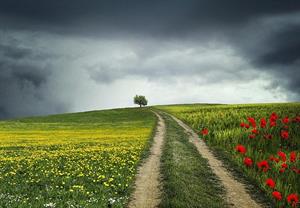
Meadows
A meadow and garden contain the same things. They both have trees, flowers, and plants. However, while a garden is grown and tended to, meadows are purely natural. They contain wildflowers and grasses instead of utility plants. The plants in the meadows are not planted by the humans.
Back to the poem, the poet says that one could find many surprises in the meadows., as long as you know how and where to look for it.
If you want to discover the surprises, you should walk softly through the grass. When you reach the little river running by the meadows, the poet asks us to stop and listen.
The poet asks us to walk softly because, otherwise, we might scare the inhabitants of the meadows away.
The poet also describes the grass as something soft like a velvet. The phrase "velvet grass" is a metaphor. The texture of the grass is compared to the softness of velvet here.
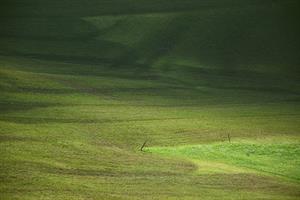
Velvet grass
While walking through the meadows, you may come across various surprises. One of those surprises are butterflies. We have seen butterflies, and have obviously heard about it. We have seen some of them flutter around us.
However, the question is, have you observed a butterfly sucking nectar from a flower? Or have you seen the sucking tube known as proboscis through which the butterflies suck the nectar?
However, the question is, have you observed a butterfly sucking nectar from a flower? Or have you seen the sucking tube known as proboscis through which the butterflies suck the nectar?
It is hard to watch a butterfly sucking nectar because it flutters away the moment we get anywhere near it.
Hence, you should walk softly through the meadows, and when you do that, you will able to see those butterflies in action.
Hence, you should walk softly through the meadows, and when you do that, you will able to see those butterflies in action.
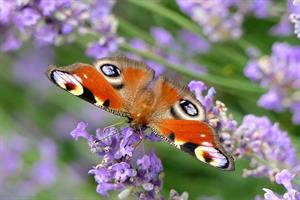
Butterflies sucking nectar
The poet says that one could discover butterflies resting upon the wildflowers such as buttercups. And if you observe closely, you could see it opening the sucking tube to draw nectar from a flower.
The poet also makes a hidden comparison between the sucking tube (proboscis) and a drinking straw. This is an instance a metaphor.
Remember the poet asking us to walk through the meadows slowly? The poet had described in the previous stanza as to how to spot a butterfly by being quiet. In this stanza, he talks about how one could spot beautiful rabbits in the meadows.
Rabbits have the habit of sitting still and quiet. It is hard to spot a rabbit as they can hide itself well among the bushes. You may have to move slowly and look around carefully to see one.
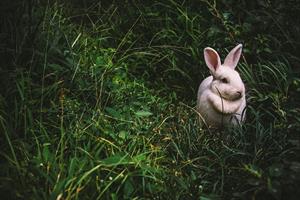
Rabbit
On the other hand, if you are not quiet, you might scare it away. Though you would miss the chance of observing it from a closer distance, you might at least be able to see it hop.
Or, as the poet says, you may realise its presence only when it hops and runs away.
Dandelion is the next surprise that one could find in a meadow. Dandelions are yellow flowers found in the wilderness. When bloomed, dandelions are yellow, and they have soft petals like any other flower.
Dandelions are a source of good amount of nectar, and hence you could easily spot several bees, insects, and birds around dandelions.
However, there is something exciting about dandelions. It changes its form in time.
However, there is something exciting about dandelions. It changes its form in time.
The soft and smooth texture turns fuzzy, and the golden-yellowish colour turns into almost white. As the poet describes, it turns into "airy parachutes". This stage, known as seedhead, is crucial in maintaining our flora because the fuzzy texture aids in pollination.
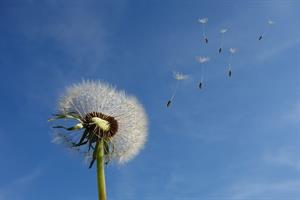
Dandelions turning into airy parachutes
All you have to do is blow onto it, and you can see it flutter across in the air. Eventually, like a parachute, the little pieces of the seedhead would settle down on earth to create more plants.
Later, the poet speaks about the meadow houses such as burrows, nests, and anthills. The meadow becomes a town by itself with all the various types of houses in it. The poet asks us to explore these houses while we are at the meadow.
The burrows are holes or tunnels found in the grounds. Animals dig them to create a space suitable for living. Burrows become homes to animals such as rabbits, moles, chipmunks, weasels, and several types of rodents.
The burrows are holes or tunnels found in the grounds. Animals dig them to create a space suitable for living. Burrows become homes to animals such as rabbits, moles, chipmunks, weasels, and several types of rodents.
Nests are built by birds. They are made on trees so that the birds could lay or leave their eggs in to develop. Sometimes nests are also found among tall grasses. Nests are considered as homes to several birds.
Besides the burrows and nests, one could also find the homes of ants in the meadows. They are called anthills or ant colony. Have you seen an ant colony? If not, have you seen the animated movie "A Bug's Life" (1998)? The film shows us what an ant colony looks like.
Back to the "Meadow Surprises", the poet describes ants’ home as an "amazing mound". The poet calls it a mound because the ant's house is in a shape of a pile. It is amazing because it is a wonder how a creature so tiny can create such an impressive structure.
The final stanza of the poem begins with a repetition of the first line from the first stanza. Hence, the line "Meadows have surprises" becomes a refrain. The stanza reinforces the earlier spoken idea as to how meadows can become a source of surprise.
The meadows also have many things to tell. It can tell us about the various animals, birds, insects, and plants in the meadows. You can spot a butterfly with its "drinking straws", a rabbit that hops and disappears, a dandelion that turns into "airy parachutes", and several other beautiful things. You can listen to the low melodies of a brook or can discover the various meadow houses. Hence, meadows have several surprises.
But you will discover these only if you know where to look and how well to listen.
The line "you may discover these yourself" can also be seen as a repetition of the line "you can find them if you look" from the first stanza. Though the lines are not repeated word-for-word, the essence and the word order are retained in both the lines. Hence, it can be seen as a form of repetition.
The meadows also have many things to tell. It can tell us about the various animals, birds, insects, and plants in the meadows. You can spot a butterfly with its "drinking straws", a rabbit that hops and disappears, a dandelion that turns into "airy parachutes", and several other beautiful things. You can listen to the low melodies of a brook or can discover the various meadow houses. Hence, meadows have several surprises.
But you will discover these only if you know where to look and how well to listen.
The line "you may discover these yourself" can also be seen as a repetition of the line "you can find them if you look" from the first stanza. Though the lines are not repeated word-for-word, the essence and the word order are retained in both the lines. Hence, it can be seen as a form of repetition.
